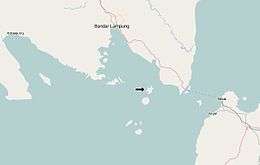Sebuku (Sumatra)
 Location of Sebuku in the Sunda Strait | |
| Geography | |
|---|---|
| Location | South East Asia |
| Coordinates | 5°52′26″S 105°31′5″E / 5.87389°S 105.51806°E |
| Area | 17.71 km2 (6.84 sq mi) |
| Administration | |
|
Indonesia | |
Sebuku (also spelled Seboekoe or Sebeekee) is an island in the Sunda Strait between Java and Sumatra. It is one of the larger islands in the strait and lies just 2.5 kilometres (1.6 mi) to the north of Sebesi and 2.3 kilometres (1.4 mi) south of Sumatra.[1] It is administratively part of South Lampung Regency, Lampung.[2]
History
At the time of the 1883 eruption of Krakatoa, Sebuku was uninhabited, but a village on Sebuku Ketjil, a small island to its east, was completely wiped out. Official records give 150 killed, with 70 being non-residents.[3]
In the 1920s, copra palms were planted on Sebuku to satisfy the growing market. However, due to a lack of maintenance the palms eventually withered and died.[4]
In 1999 a sunken Japanese ship was found near Sebuku by divers preparing for an underwater photography contest. Its age is unknown.[5]
Geography
Sebuku is a low island, located in the eastern part of the mouth of Lampung Bay,[6] 2.5 kilometres (1.6 mi) north of Sebesi and 2.3 kilometres (1.4 mi) south of Sumatra.[1] It covers a total area of 17.71 square kilometres (6.84 sq mi).[7] It is administratively part of South Lampung Regency, Lampung.[2]
Sebuku has a centre composed of andesite, indicating an early volcanic history. This centre has been dated to the Quaternary and has been called an early manifestation of volcanism in the Sunda Strait.[8] The substrate on the northern side of the island consists of fossilised coral, mud and sand, while on the eastern side of the island the substrate consists of mud, sand, gravel, and both live and fossilised coral.[6] The outside is fringed by a reef.[9]

Ecology
Sebuku, along with Sebesi, has been noted as a "stepping stone" for butterfly migration between Sumatra and Krakatoa. There are numerous butterfly species from both Java and Sumatra on Sebuku.[10] Four species of ants have been found on Sebuku, fewer than Sebesi and Krakatoa.[11] These included ants not found on Krakatoa, thought to be descended from fauna that survived the 1883 eruption.[12]
The waters near Sebuku have fewer echinoderms than further into the Lampung Bay. This is thought to be from exploitation and poor resource management.[13]
Due to cultivation, few natural forests remain on Sebuku.[11] However, along the eastern coast of Sebuku there are many mangroves.[14] There are also tropical plants found throughout the island.[9]
Tourism
Sebuku is a popular destination for snorkelling and diving, with tourists generally arriving by boat from Candi village on Sumatra.[15]
References
- 1 2 Junichi Yukawa, p. 2
- 1 2 "Profile dan Potensi Kabupaten Lampung Selatan" [Profile and Potential of South Lampung Regency] (in Indonesian). Government of South Lampung Regency. Retrieved 6 July 2011.
- ↑ Simke & Fiske
- ↑ Touwen, p. 176
- ↑ "Sunken Japanese ship spotted". The Jakarta Post. 19 August 1999. Retrieved 6 July 2011.
- 1 2 Darsono and Aziz, p. 110
- ↑ "Peraturan Daerah Provinsi Lampung Nomor 6 Tahun 2007 tentang Rencana Pembangun Jangka Panjang Daerah Provinsi Lampung Tahun 2005 – 2025" [Local Legislation of the Province of Lampung Number 6 of the Year 2007 regarding the Long-Term Development Plans for Lampung from 2005 – 2025] (in Indonesian). Government of Lampung. Retrieved 6 July 2011.
- ↑ Barber et al., p. 109
- 1 2 Darsono and Aziz, p. 105
- ↑ Junichi Yukawa, p. 8
- 1 2 Asfiya et al., p. 2
- ↑ Asfiya et al., p. 8
- ↑ Darsono and Aziz, p. 111
- ↑ Soeroyo and Suyarso, p. 97
- ↑ Vaisutis, p. 482
Bibliography
- Asfiya, Wara; Ubaidillah, Rosichon; Yamane, Seiki (2008). "Ant (Hymenoptera: Formicidae) of the Krakataus, and Sebesi and Sebuku Islands" (PDF). Treubia. 36: 1–9. Retrieved 6 July 2011.
- Barber, A. J.; Crow, M. J.; Milsom, J. S., eds. (2005). Lonely Planet: Indonesia. Bath, United Kingdom: The Geological Society Publishing House. ISBN 1-86239-156-4.
- Darsono, Prapto; Aziz, Aznam. "Khinodermata dari Beberapa Pulau di Teluk Lampung, Lampung, Sumatera" [Echinodermata Fauna on Some Islands of the Lampung Bay, Lampung, Sumatera] (PDF) (in Indonesian). Lembaga Ilmu Pengetahuan Indonesia. Retrieved 6 July 2011.
- Junichi Yukawa; Tukirin Partomihardjo; Osamu Yata; Toshira Hirowatari (31 March 2000). "An Assessment of the Role of Sebesi Island as a Stepping-stone for the Colonisation of the Krakatau Islands by Butterflies" (PDF). Kyushu University. Retrieved 6 July 2011.
- Simke, Tom; Fiske, Richard (1983). Krakatau 1883; The Volcanic Eruption & Its Effects. Washington, D.C.: Smithsonian. ISBN 0-87474-841-0.
- Soeroyo; Suyarso. "Kondisi dan Inventarisasi Hutan Mangrove di Kawasan Teluk Lampung" [Condition and Inventaritation on the Mangrove Forest of Lampung Bay] (PDF). Lembaga Ilmu Pengetahuan Indonesia. Retrieved 6 July 2011.
- Touwen, Jeroen (2001). Extremes in the archipelago: trade and economic development in the Outer Islands of Indonesia, 1900–1942. Leiden: KITLV press. ISBN 90-6718-159-5.
- Vaisutis, Justine (2007). Lonely Planet: Indonesia. Lonely Planet. ISBN 1-74104-435-9.